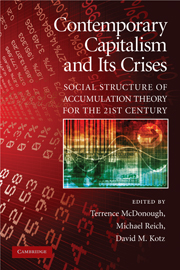Book contents
- Frontmatter
- Contents
- List of Tables
- List of Figures
- List of Contributors
- Acknowledgments
- Introduction: Social Structure of Accumulation Theory for the 21st Century
- PART I THE THEORY OF SOCIAL STRUCTURES OF ACCUMULATION
- PART II GLOBALIZATION AND THE CONTEMPORARY SOCIAL STRUCTURE OF ACCUMULATION
- PART III THE CONTEMPORARY SOCIAL STRUCTURE OF ACCUMULATION IN THE UNITED STATES
- PART IV SOCIAL STRUCTURE OF ACCUMULATION THEORY AND TRANSFORMATIONS OF THE CAPITALIST PERIPHERY
- Index
- References
Introduction: Social Structure of Accumulation Theory for the 21st Century
Published online by Cambridge University Press: 05 June 2012
- Frontmatter
- Contents
- List of Tables
- List of Figures
- List of Contributors
- Acknowledgments
- Introduction: Social Structure of Accumulation Theory for the 21st Century
- PART I THE THEORY OF SOCIAL STRUCTURES OF ACCUMULATION
- PART II GLOBALIZATION AND THE CONTEMPORARY SOCIAL STRUCTURE OF ACCUMULATION
- PART III THE CONTEMPORARY SOCIAL STRUCTURE OF ACCUMULATION IN THE UNITED STATES
- PART IV SOCIAL STRUCTURE OF ACCUMULATION THEORY AND TRANSFORMATIONS OF THE CAPITALIST PERIPHERY
- Index
- References
Summary
Since the 1994 publication of our volume, Social Structures of Accumulation: The Political Economy of Growth and Crisis (Kotz et al. 1994), social structure of accumulation (SSA) theory has continued to inspire a substantial outpouring of articles and books in a variety of disciplines. The purpose of this new volume is to provide a definitive account of the state of SSA theory and its applications today, 30 years after SSA theory first emerged, and well over a decade since our previous volume was published. SSA theory seeks to explain, among other things, why long periods of relative economic stability alternate with long periods of economic crisis. For this reason, it is well suited to help understand the factors underlying the financial and economic crisis of global capitalism that broke out in 2007–08.
SSA theory was developed in the 1970s and early 1980s by David Gordon, Richard Edwards, and Michael Reich (1982) as a way of relating apparent long cycles of growth and stagnation in capitalist history to periods of change in the institutional structure of capitalism. Contrary to the sunny picture of conventional equilibrium economics, capitalist history appeared to be punctuated by periodic crises of unusual depth and length. And contrary to some conventional Marxian expectations, capitalism had not fallen into a permanent state of depression or stagnation. Subsequent to the crisis periods, capitalist economies experienced prolonged periods of relatively vigorous and stable growth and accumulation.
- Type
- Chapter
- Information
- Contemporary Capitalism and its CrisesSocial Structure of Accumulation Theory for the 21st Century, pp. 1 - 20Publisher: Cambridge University PressPrint publication year: 2010
References
- 4
- Cited by

